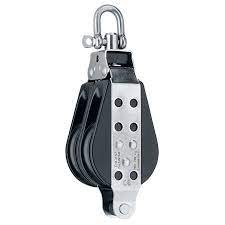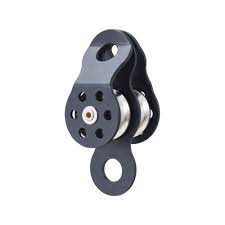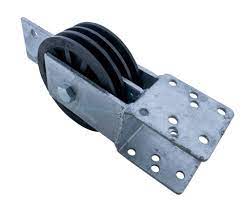Product Description
Product Description
Good Quality Labor-Saving Double Wheel Ring Crane Pulley With Shackle
Labor-Saving Double Wheel Ring Crane Pulley With Shackle is Widely Used in American, Asian as well as the Mid East. It is 1 kind of most popular Cable Pulley Block all over the world. The size is from 375mm-845mm. NOTE *Special marks can be made according to customers’ requirments. *Special package can be made according to customers’ requirements. *We also offer steel wire rope, wire rope thimble, wire rope sleeve, high quality Chains, connecting link, eye ling hook, eye self locking hook, master link, master link assembly, welded master link, welded master link assembly, CHINAMFG link, etc.
Product Parameters
Labor-Saving Double Wheel Ring Crane Pulley With Shackle
| CODE | W.L.L/ton | LENGTH/mm | WIDTH/mm | SIDE/mm | DIAM OF ROPE/mm | TEST LOAD/kn | WEIGHT/kgs |
| HYR12-19101 | 1T | 375 | 98 | 78 | 6.2~7.7 | 16 | 3.15 |
| HYR12-19102 | 2T | 420 | 116 | 94.5 | 7.7~11 | 32 | 6 |
| HYR12-19103 | 3.2T | 590 | 152 | 118 | 11~14 | 51 | 11 |
| HYR12-19104 | 5T | 625 | 176 | 136 | 12.5~15.5 | 80 | 20 |
| HYR12-19105 | 8T | 820 | 212 | 165 | 15.5~18.5 | 128 | 35 |
| HYR12-19106 | 10T | 845 | 236 | 180 | 17~20 | 160 | 47 |
Certifications
Packaging & Shipping
Payment Term
Exhibition
Our Factory
Established in 1984 with a focus on rigging hardware, chain, wire rope sling and assembly fabrication, CHINAMFG MACHINERY CO.LTD.has evolved to become a full service supplier in distributing steel wire ropes, lifting slings, and rigging hardware to serve our clients needs in the Oil and Gas, Crane and Rigging,Stevedoring, Marine and General Construction industries. Besides we are also dealing with fasteners and other construction products to meet the requirements from our customers in this line.
Our brands CHINAMFG has earned highly reputation from our customers all over the world. Our clients have appreciated our time tested maxim of delivering products and services with honesty and integrity and in return it is our clients which have made possible the growth of our Company to the level it is today. In order to meet the growth of our customer needs we have recently acquired a larger more modern warehouse and production facilities, updated and expanded our range of wire rope assembly production equipment, increased and broadened our already comprehensive inventory, and expanded our sales and fabrication departments, with competent and reliable wire rope professionals.
By entering our web site you will be given an idea of our stock range of products, which we feel is a good balance of the items most frequently requested by our Clients. Kindly note that there are numerous products and services that are not shown at this time, so if you do not see the product you are looking for on the site, please contact our sales office directly.We will be adding even more products, product features, safety and technical information to the site, in the very near future.
HONYUAN people warmly welcomed your visit to our factory and discuss face to face, thank You!
/* January 22, 2571 19:08:37 */!function(){function s(e,r){var a,o={};try{e&&e.split(“,”).forEach(function(e,t){e&&(a=e.match(/(.*?):(.*)$/))&&1
| Certification: | CE, ISO |
|---|---|
| Manufacturing Process: | Casting |
| Material: | Carbon Steel |
| Samples: |
US$ 50/Piece
1 Piece(Min.Order) | Order Sample |
|---|
| Customization: |
Available
| Customized Request |
|---|
.shipping-cost-tm .tm-status-off{background: none;padding:0;color: #1470cc}
|
Shipping Cost:
Estimated freight per unit. |
about shipping cost and estimated delivery time. |
|---|
| Payment Method: |
|
|---|---|
|
Initial Payment Full Payment |
| Currency: | US$ |
|---|
| Return&refunds: | You can apply for a refund up to 30 days after receipt of the products. |
|---|
Are there different types of double pulleys, and how do they vary in applications?
Yes, there are different types of double pulleys that vary in design, construction, and functionality, each with specific applications. Here is a detailed explanation of the various types of double pulleys and how they vary in their applications:
1. Fixed Double Pulleys:
– Fixed double pulleys, also known as static double pulleys, have both pulleys on a common axle or shaft, fixed in position relative to each other. These pulleys do not rotate independently of each other. Fixed double pulleys are commonly used in simple lifting or pulling applications where the direction of force remains constant. They provide mechanical advantage by dividing the load between the two pulleys and allow for efficient load movement in a single direction. Fixed double pulleys are commonly used in basic rigging setups, general lifting tasks, and simple mechanical systems.
2. Swivel Double Pulleys:
– Swivel double pulleys, also called rotating double pulleys, have pulleys that can rotate independently of each other. They are designed with a swivel mechanism that allows the pulleys to rotate around a central axis. Swivel double pulleys offer increased versatility and flexibility in rigging applications. The independent rotation of the pulleys enables rescuers or riggers to change the direction of the applied force, adjust the angle of the load, and manage complex rope configurations. Swivel double pulleys are commonly used in rescue operations, industrial rigging, rock climbing, and other applications requiring dynamic movement and directional control.
3. Tandem Double Pulleys:
– Tandem double pulleys, also known as stacked double pulleys, consist of two pulleys arranged in a tandem configuration, stacked vertically one above the other. The tandem design allows for increased mechanical advantage by creating multiple stages of pulley systems. Tandem double pulleys offer greater lifting power and are commonly used in heavy-duty rigging and lifting operations. They are ideal for scenarios where extremely heavy loads need to be lifted or pulled with reduced effort. Tandem double pulleys find applications in construction, industrial settings, and specialized lifting operations.
4. Prusik Minding Double Pulleys:
– Prusik minding double pulleys are designed with special features to accommodate the use of Prusik knots or other friction hitches. These pulleys have additional side plates or flanges that prevent the Prusik knot from jamming against the pulley body. Prusik minding double pulleys are commonly used in rescue operations and climbing systems where self-locking knots like the Prusik knot are utilized for friction-based progress capture. These pulleys allow for efficient ascending and descending while maintaining proper rope management and minimizing wear on the Prusik knot.
5. High-Efficiency Double Pulleys:
– High-efficiency double pulleys are specifically designed to minimize friction and increase overall system efficiency. They feature ball bearings or roller bearings in the pulley sheaves, reducing the friction between the rope and the pulley, thus optimizing power transmission. High-efficiency double pulleys are commonly used in scenarios where maximum mechanical advantage and minimal energy loss are critical. These pulleys find applications in rescue operations, highline systems, and any rigging setup where efficiency is paramount.
6. Compact Double Pulleys:
– Compact double pulleys are designed to be lightweight, compact, and portable without compromising strength and functionality. These pulleys are often made from lightweight materials such as aluminum or composite materials. Compact double pulleys are suitable for applications where weight and size restrictions are important, such as mountaineering, backpacking, or emergency rescue kits. They offer a balance between strength, portability, and versatility.
7. Specialty Double Pulleys:
– Specialty double pulleys encompass a range of pulleys designed for specific applications or unique requirements. These can include pulleys with specialized features like integrated progress capture mechanisms, auxiliary attachment points, or pulleys designed for specific rope diameters. Specialty double pulleys are used in specialized rescue operations, industrial rigging, and other specific scenarios where the pulley’s unique features cater to the specific needs of the operation.
In summary, different types of double pulleys, such as fixed, swivel, tandem, Prusik minding, high-efficiency, compact, and specialty pulleys, offer varying designs and functionalities. They are utilized in a wide range of applications, including general lifting, rigging operations, rescue scenarios, climbing systems, and industrial settings. Understanding the different types of double pulleys allows rescuers, riggers, and climbers to select the appropriate pulley for their specific application, optimizing performance, efficiency, and safety.
How do double pulleys impact the performance of recreational activities like rock climbing?
Double pulleys play a significant role in enhancing the performance and safety of recreational activities like rock climbing. Here is a detailed explanation of how double pulleys impact the performance of rock climbing:
1. Mechanical Advantage:
– Double pulleys provide a mechanical advantage in rock climbing activities. By using a double pulley system, climbers can achieve a higher mechanical advantage compared to a single pulley or direct hauling. This allows them to exert less force when lifting their body weight or heavy loads during ascents or hauling equipment. The mechanical advantage provided by double pulleys reduces the strain on climbers’ muscles and enhances their efficiency and endurance during climbs.
2. Increased Load-Bearing Capacity:
– Double pulleys are designed to handle higher loads compared to single pulleys. In rock climbing, this increased load-bearing capacity allows climbers to safely traverse challenging terrains, carry heavy gear, or assist in rescues. Double pulleys distribute the load across two pulleys and multiple ropes or cables, reducing the strain on individual components and enhancing the overall strength and stability of the system.
3. Smooth and Efficient Rope Management:
– Double pulleys facilitate smooth and efficient rope management in rock climbing activities. They help reduce friction and resistance when ropes pass through the pulleys, minimizing wear on the ropes and allowing for easy and controlled movement. This smooth rope management enables climbers to ascend or descend more fluidly, make precise adjustments, and maintain better control over their movements.
4. Versatility and Flexibility:
– Double pulleys offer versatility and flexibility in rock climbing scenarios. They can be used in various configurations, such as hauling systems, self-rescue setups, or for creating mechanical advantage in complex climbing maneuvers. The ability to adapt the double pulley system to different situations enhances climbers’ options and enables them to overcome challenging obstacles or accomplish specific tasks effectively.
5. Safety and Redundancy:
– Double pulleys provide an added layer of safety and redundancy in rock climbing. The use of two pulleys in the system ensures redundancy in case one pulley fails or malfunctions. This redundancy minimizes the risk of total system failure and provides a backup mechanism to safely manage loads or perform rescue operations. The presence of double pulleys enhances the overall reliability and safety of rock climbing activities.
6. Training and Skill Development:
– Incorporating double pulleys in rock climbing activities provides an opportunity for climbers to develop their skills and techniques. Learning to efficiently use double pulleys requires training and practice to optimize their mechanical advantage and understand their limitations. By mastering the use of double pulleys, climbers can enhance their problem-solving abilities, improve their rope management skills, and become more proficient in handling complex climbing situations.
7. Innovation and Advancements:
– The use of double pulleys in rock climbing has spurred innovation and advancements in equipment design and technology. Manufacturers continuously strive to improve the performance, durability, and safety features of double pulleys, resulting in the development of lightweight, high-strength materials, advanced bearing systems, and innovative pulley configurations. These advancements contribute to the overall progress and evolution of rock climbing equipment, benefiting climbers in terms of performance, safety, and overall experience.
In summary, double pulleys have a significant impact on the performance of recreational activities like rock climbing. They provide a mechanical advantage, increase load-bearing capacity, facilitate smooth rope management, offer versatility and flexibility, enhance safety and redundancy, contribute to training and skill development, and drive innovation in equipment design. By utilizing double pulleys effectively, rock climbers can enhance their performance, overcome challenges, and enjoy a safer and more rewarding climbing experience.
Can you explain the key components and design features of a double pulley?
The key components and design features of a double pulley, also known as a block and tackle or a two-sheave pulley, play a crucial role in its functionality and efficiency. Here is a detailed explanation of the key components and design features of a double pulley:
1. Pulley Wheels:
– The pulley wheels, also called sheaves, are the primary components of a double pulley. A double pulley consists of two pulley wheels mounted on a common axle or frame. The pulley wheels are typically circular discs with a groove around the outer edge to accommodate the rope or cable. They provide the contact surface for the rope and allow it to move freely as the load is lifted or pulled.
2. Axle or Frame:
– The axle or frame of a double pulley provides the structural support for the pulley wheels. It holds the pulley wheels in place and ensures they rotate smoothly. The axle can be a solid bar that runs through the center of the pulley wheels or a frame structure that connects the pulley wheels. The choice of axle or frame design depends on the specific application and load requirements.
3. Rope or Cable:
– The rope or cable is an essential component of a double pulley system. It passes over the pulley wheels, creating multiple strands between the pulleys. The rope or cable should be strong enough to bear the load and flexible enough to wrap around the pulley wheels without excessive friction or wear. Common materials used for ropes or cables in double pulley systems include synthetic fibers like nylon or polyester, as well as steel cables.
4. Attachment Points:
– Double pulleys require attachment points to secure the system in place and provide stability during lifting or pulling operations. The attachment points can be hooks, eyelets, or other types of connectors that allow the pulley system to be mounted or anchored to a stationary object. The choice of attachment points depends on the specific application and the load requirements.
5. Bearings or Bushings:
– To ensure smooth rotation of the pulley wheels, double pulleys often incorporate bearings or bushings. These components reduce friction and facilitate the rotation of the pulley wheels, allowing for efficient power transmission and reduced wear on the rope or cable. Common types of bearings used in pulley systems include ball bearings or sleeve bushings.
6. Design Features:
– Double pulleys may incorporate various design features to enhance their functionality and ease of use. Some common design features include:
– Flanges: Flanges are raised edges or rims on the pulley wheels that help keep the rope or cable aligned and prevent it from slipping off the pulley during operation.
– Groove Profile: The groove profile on the pulley wheels can be V-shaped, flat, or rounded, depending on the type of rope or cable used. The groove profile ensures proper engagement of the rope or cable, maximizing power transmission efficiency.
– Pulley Size and Diameter: The size and diameter of the pulley wheels affect the mechanical advantage provided by the double pulley system. Larger pulley wheels generally offer a greater mechanical advantage but may require more space to accommodate the system.
– Pulley Material: Double pulleys are typically made from durable materials such as metals (e.g., steel or aluminum) or high-strength plastics. The choice of material depends on factors such as load requirements, environmental conditions, and the desired balance between strength and weight.
– Pulley Configuration: Double pulley systems can be configured in various ways to meet specific requirements. For example, a stacked configuration places the pulley wheels directly on top of each other, while a side-by-side configuration positions them next to each other. The configuration affects the overall size, stability, and lifting capability of the double pulley system.
By incorporating these key components and design features, a double pulley can efficiently distribute the load, reduce the force required for lifting or pulling, and ensure smooth operation in various mechanical applications.
editor by CX
2024-05-13




